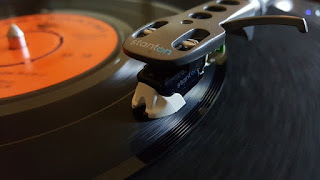Garden Pic Wednesday: Turtles & Blooms!
A Box Turtle Enjoying Popcorn
Hubby likes to eat a big tub of popcorn at the movies, then gets the free refill and we bring it home to toss out for the birds and the occasional turtle.
Got this shot last weekend. He has his eye on me, even though I'm a good 10 feet away.
Big Blue Blooms!
I recently read watering Hydrangea's with a little baking soda mixed in water helps them flourish, especially if they're not performing well.
(I realized the woman sharing this had white Hydrangeas and watering with baking soda added to water is a great idea for white or pink Hydrangeas, which, of course, aren't negatively effected by it.)
But for blue or purple shades of Hydrangeas, do not use baking soda to water them, unless you want to change their color to pink or light lavender.
To keep Hydrangea's their bluest blue, they need a sulfur based fertilizer, which you can buy or you can use Epsom Salts.
For things you want to stay Blue or Purple: add one Tablespoon of Epsom Salts to your watering can:
blueberries, blue or purple hydrangeas, lavender daylillies, Agapanthus, Purple Beans, Purple Bell Peppers, etc.
But for blue or purple shades of Hydrangeas, do not use baking soda to water them, unless you want to change their color to pink or light lavender.
To keep Hydrangea's their bluest blue, they need a sulfur based fertilizer, which you can buy or you can use Epsom Salts.
For things you want to stay Blue or Purple: add one Tablespoon of Epsom Salts to your watering can:
blueberries, blue or purple hydrangeas, lavender daylillies, Agapanthus, Purple Beans, Purple Bell Peppers, etc.
Also blue hydrangeas benefit from a few copper pennies buried down by their roots for a bluer blue.
However, for other things not-blue or purple, watering with a Tablespoon of baking soda added can help them flourish: particularly garden veggies and flowers of other colors.
Harvesting 4 O'Clock Seeds:
Four O'clocks are a super easy, old fashioned cottage flower to grow in your beds. It gets about 12 to 24 inches tall, is a great space filler being fairly leafy and blooms at night, feeding moths and other night-feeders.
The seeds are super easy to collect, being large.
This is what a 4 O'clock looks like in bloom:
This is what a 4 O'clock seed looks like:
It's about 3/8 inch in size and looks like a little black egg in a nest.
Just pick as you find them, store them in an envelope marked with the year, then plant next spring.
In the north, 4 O'clocks are annuals; in the south, where the soil doesn't freeze, they're perennial.









Comments
Post a Comment
Thanks for leaving a comment!